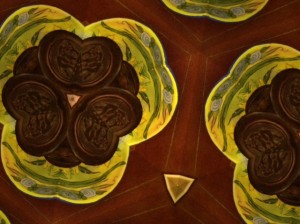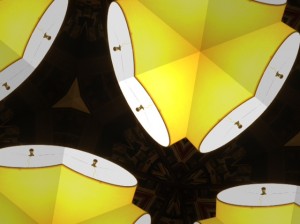Inspiring Interior Design (Part 10)
By Asher Crispe: August 17, 2012: Category Inspirations, Quilt of Translations
Appealing Furniture
Every home can be viewed as a model home, as a reflection of the Temple which itself microcosmically models reality. As we explained earlier, the Temple is principally built out of stones and those stones represent letters which in turn construct language. Returning to Heidegger once more: ‘Language is the house of Being’ [Havayah]; but this is not just any language. The sages established a substitution wherein prayer would take the place of the Temple offerings. In order to dwell in this ‘house’ one has to furnish it with the words of prayer. Consequently, the four essential items of furniture–which we took inventory of in the last article–will now make a second appearance, only this time they come wrapped in the interpretation of the Zohar which engages them as the reification of the various stages of daily prayer.
In the story of Elisha we find that he is referred to as ‘a holy man of God’ who visits the home of a prominent women in Shunem regularly. On account of this, she suggests to her husband that they should make him a special room. According to the Zohar, this special room (literally called a small, walled attic) alludes the (feminine) Divine presence or Shekhinah while the set of furnishings signify four of her ‘rectifications’ or ‘decorations’ (tikunim).
How does a ‘small, walled attic’ (aliyat kir k’tanah) carry this connotation? Once again, the Hebrew reveals what’s excluded by the selectivity of translation. The original expression for ‘attic’ (aliyat) could also be rendered as ‘upper’ or better yet ‘ascension’ (as it derives from the word aliyah meaning ‘to ascend’ or ‘go up’). To conceptualize the experience of the Divine Presence (literally: the ‘indwelling’ or ‘immanence’ of Divinity), we need to think about reserved spaces (‘hotspots’ in the nomenclature of today’s digital age) where one can enter into a focused and attentive relationship with God. Everything that fills this space is likewise dedicated to our relationship with God. It all becomes holy.
Reinstalling this term back into its initial translation as ‘attic,’ the space above all of the normal space in the house–the transcendent space–designates the ‘story’ above. The levels of a building are after all called stories: first floor is the first ‘story,’ the second floor the second ‘story.’ Thus, whichever story we reside on relates to our personal ‘stories,’ while the upper chamber, the attic as the ‘story above,’ tells a tale the way God would tell it. The aliyat is a kind of hyperspace.
What else do we know of this upper chamber? The book of Kings II mentioned that it is walled (kir). A wall may be likened to a boundary condition. Spiritualized space restricts access. Moreover, it’s described as ‘small.’ Perhaps we could depict it as a micro-fracture or mini black hole in the fabric of the universe which exhibits exotic behavior–a spacial anomaly. Some ambiguity exists as to whether or not the third term in the phrase–‘small’ (k’tanah)–is predicated of the room or the wall. Either way, we are dealing with a minimal phenomenon. The concealment of the world remains too strong and cloaks the Divine Presence with the exception of these dedicated pockets. Either it is minimally ‘bounded’ by the small wall which amounts to a thin veil, or it is minimally extended in space such that the signal generated there drops off rapidly with distance.
In both cases, we are dealing with a highly circumscribed zone of influence. During the times of the Temple (especially in the future), the influence of the Divine Presence will be felt everywhere throughout the world. In its absence, our capacity to tap into the Divine Presence has diminished as its board-cast radius has shriveled up into a space so small that it generally admits only a one person occupancy.
As the sages of the Talmud teach (Brachot 8a): ‘…from the day that the Temple was destroyed, God has not had a [dwelling] place in the world other than the four cubits [roughly the amount of physical space occupied by a person] of Jewish law (halachah).” Thus, we become, through our actions, the house within the house or the house in place of the house–the place for God to dwell. As the residence of the Divine presence we must locate within ourselves the basic furnishings of this elevated interior space. The Zohar instructs us as to how prayer will fill this room with a bed, a table, a chair and a lamp.
Starting with the bed–which is primarily associated with the evening and thus the order of evening prayers (Arvit)–the Zohar goes on to remind us that the patriarch Yaakov (Jacob) established this prayer. It is technically the first prayer of a new day because in the Jewish calendar the day begins at nightfall. It is also interesting to note that Yaakov lays claim to the ‘bed’ in that the Torah maintains that his bed was complete in that he was the progenitor of twelve tribes–the ‘full-house’ of Israel.
After the bed comes the table. The major opening section of the morning prayer (Shacharit) details with the workings of the offering and sacrifices (Korbanot) as well as songs and verses of praise (Pesukei D’Zimrah) in the Temple. This phrase of prayer may be likened to a table in that the table (as we have mentioned previously) resembles the sacrificial altar. One figure above all personifies the table–that of Dovid (King David). He brands and has branded his relationship with God as a table. He offers his whole life on this table, or rather his inner life has been transformed into a platform for sanctification and praise.
Formulated in the manner that teachers ask small children: ‘if you had to be a piece of furniture, then what piece of furniture would you be?’ A snapshot of Dovid’s interior may be gleaned from Psalms 23: “You [God] prepare a table for me in the full presence of my enemies.” The word translated here as “before me” is l’fanai which the Chassidic masters point out stems from the same root a p’nai (face) and penimiut (interior). Hence, the table is arranged within Dovid. His entire being turns into a table. He embodies this part of the morning prayer.
No one in the Torah is most deserving of an honorary chair than Avraham (Abraham). Avraham was the first to proclaim the oneness of God to the world. The next stage of prayer is the Shema wherein a person proclaims the oneness of God with the words: “Hear Israel, God is Your God, God is one.” Echad means ‘one’ in Hebrew and it is the numerical equivalent to thirteen which is also the sum of the letters of the word ahavah or love. Avraham is the personification of love (Isaiah 41:8 “…Avraham who loved Me…”) and a living expression Divine unity (Ezekiel 33:24 “…Avraham was one…”). Finally, the connection to the chair can be found in Isaiah 16:5 “The throne [chair] will then be established with lovingkindness….” Thus, the seat of lovingkindness which anchors Divine unity as exemplified by Avraham gets expressed through the Shema which has been dubbed the ‘sitting prayer.’ The Shema, more than any other prayer, requires us to sit. Kabbalistically it even hints at the world of the Throne (chair).
Our last stop on the prayer train is the Amidah, which literally translates as the ‘Standing Prayer.’ Of all the levels outlined in the Zohar, this one proves the most challenging to explain. Unlike the Shema prayer which can be ‘seated’–where the concept of Divine unity can be grasped and allowed to settle within our consciousness– during the Amidah prayer we remain silent rocking back and forth fully upright as we cleave to the ungraspable with the whisper of the language of the unsayable. Juxtaposed one to the other, the Shema (meaning ‘to hear’) implies understanding whereas, the highest spiritual experiences transcend understanding and can hardly be articulated. As a result they are barely audible, if not silent.
The figure in the Torah who embodies the ‘standing’ prayer has to withstand the greatest of ordeals–that of the Akedah (the binding of Isaac). Though Avraham had to bind his son Yitzchak (Isaac) it was Yitzchak who had to have the self-restraint to stand the test. The paradoxes and contractions of the binding of Yitzchak rank as the greatest enigmas of the Torah. His commitment to God in allowing himself to be bound leaves us trembling to this day (ideally a small sense of this awe ripples through a person who is standing before God during the Amidah prayer rocking back and forth.)
On account of this greatest of sacrifice being riddled in mystery, some of the highest lights (those which under normal circumstances can never appear) shine forth into the world. The Zohar states that these lights represent the menorah (lamp). Transcendental Illumination descends from the heights of spiritual ecstasy from the direct encounter with the Divine. Alternatively named the Shemoneh Esrei (‘The Eighteen’) for its eighteen blessings (before a nineteenth was added in) the Amidah deals with every aspect of one’s life (chai or ‘life’ actually equals eighteen in Hebrew). Therefore, Yitzchak’s offering up of his whole life, his entire being, secures his place as the lamp or menorah. We need to light up our lives and let our lives be a light until the world.
In sum, our four levels are furnishing different states of consciousness that evolve with the progression of our daily prayers. At the start, we are unconscious in the night on the bed. From out the the darkness we try to make contact. Then at the dawn of consciousness, our spiritual connection is laid out before us on the table. We sit, but more importantly we are the chair, the seat of understanding Divine unity. Finally, we stand in the Divine Presence allowing our light to shine forth silently cleaving to our Creator.
Prayer is all about connection (the word mitzvah ‘commandment’ also derives from ‘tzavta v’chibur’ which means to ‘bind and connect’). If we add up the numerical values of all four of our pieces of furniture (which have now been assigned to various rungs in the ladder of prayer) we will discover that they add up to 824 (bed: mita [54], table: shulchan [388], chair: kisei [81], lamp: menorah [301]) which equals the famous expression simcha shel mitzvah (‘the joy of the connection [commandment/good deed]’). So let all of our furniture be appealing (let it be prayer) and enhance the joy of our spiritual connections.
Next we turn to the topics of light and color as our trek through the interior design of our house continues in Part Eleven.
http://www.interinclusion.org/inspirations/inspiring-interior-design-part-11/

























;)
;)
;)
;)
;)
;)
;)
;)
;)
;)
